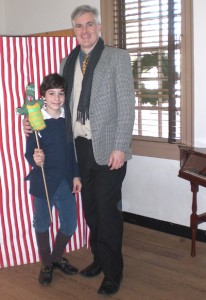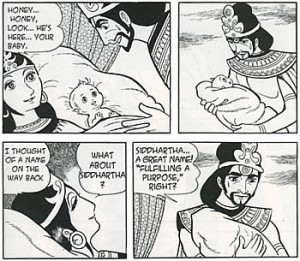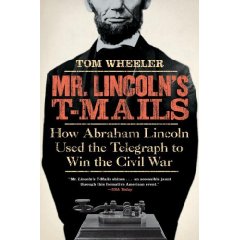












|
|

|
 |
||
 |
"Thank you so much for making a comic that children WANT to read and learn from." Niesa Wilhelm, 2nd grade teacher in Virginia |
|
|
|
||
Posts Tagged ‘history’
Happy Historical Holidays!
Written on Thursday, December 25th, 2008 [permanent link]Here you go: historical comic book artist, costumed son and DRAGON!!! This is right after one of this month’s holiday puppet shows that my youngest, Truman, did at Colonial Williamsburg’s Geddy House, just off the green that runs up to the Governor’s Palace.
It’s a great way to grow up, walking in the footsteps of kids from across hundreds of years. Truman got to be the dragon in a holiday production of the St. George and the Dragon folk tale. This was his first year as a costumed junior interpreter at the Geddy, and I could not be more proud of him! I’ve learned a lot about the Colonial era from the time both my sons have spent as junior interpreters.
When I started drawing the daily Chester the Crab history strips for the Daily Press in 1999, my oldest son, Samuel, was as old as the target school audience. (And he was attending the elementary school next to Colonial Williamsburg’s Historic Area about the same time that a Geddy descendant did!) So Samuel got to be a character moving through time and learning with Chester. But now, a decade later, Truman’s patience has paid off – all the new stuff I’m drawing features HIM! I’m working on a Colonial Williamsburg comic right now that features Truman and his personality in this garb! It’s great to have your historical character so close . . .
Tags: Bentley Boyd, Chester Comix, Chester the Crab, Colonial Williamsburg, comic books, Geddy House, history, nonfiction graphic novel
Posted in Colonial Williamsburg | No Comments »
Comic book review: "Buddha: Kapilavastu," by Osamu Tezuka
Written on Monday, September 8th, 2008 [permanent link]AGE APPROPRIATE: 11th grade and up (nudity and violence)
COLOR: no
PAGES: 400
I’ve spent a lot of my free reading time this summer digging into ancient India. One of the biggest school districts in Virginia has begun to teach ancient India to elementary students, and I’d like to draw a comic book about it this fall. As I have waded through library books and old National Geographics, I also looked for any other graphic novels on the subject.
I found an 8-part epic about the life of Buddha, written and drawn by Japanese manga forefather Osamu Tezuka! I’m not a fan of manga comix, so this was a chance to learn not only about the life of the founder of Buddhism but also to try swimming in a form of comix that is very popular with American teens.
There is a lot of vitality to Tezuka’s storytelling. He’s called “the Japanese Walt Disney,” and “Buddha: Kapilavastu,” the first of his 8-volume series, has a lot of action and silliness – in many cases the animals LOOK like they came from the Walt Disney studio. It amazes me as a cartoonist that even within a scene or even one panel Tezuka draws some characters seriously and others in very cartoony fashion. He even puts himself into some panels — with scribbles over his head identifying himself! The unevenness between his panels showing the scenery of India and panels showing goofy sentry jokes and panels dropping modern references make for a strange ride. And American audiences may be unsettled by the casual nudity of a mother and a small boy or the violence (blood is shown black since the comic is not in color). But maybe this all-but-the-kitchen-sink approach is the appeal of manga – Tezuka certainly uses all the elasticity of the art form (sometimes characters bounce off the panel borders or break them into pieces).
But if it’s good manga, does that make it a good telling of the life of the founder of one of the world’s great religions? The person who becomes Buddha is only born in volume 1! He appears on only a handful of the 400 pages, in only two of the 12 chapters. So I learned much more about Tezuka as an artist than I did about the historical Buddha. The rest of this first volume is filled with the antics of fictional characters — some of whom don’t survive this volume and so have no impact on the life of Buddha. Some of their stories deliver messages about the caste system in India, but it’s also clearly filler — Japanese manga comix are often published weekly, so there’s much more volume to their stories than you find in American comix.
So the bottom line is: do I think the path to enlightenment can be found on my way to paying $15 for each of the next seven volumes in the story????
Tags: Bentley Boyd, Buddha, comic book, graphic novel, history, India, manga, Osamu Tezuka
Posted in Graphic Novel Review | 1 Comment »
Book Review: Mr. Lincoln’s T-Mails by Tom Wheeler
Written on Friday, August 29th, 2008 [permanent link]I enjoyed all the comparisons between Barack Obama and Abraham Lincoln made at the Democratic National Convention this week. If anything, Lincoln was LESS experienced at the time of his election than Obama is now: Lincoln had only one 2-year term in the House of Representatives and was a complete dark horse candidate at the Republican convention in the summer of 1860 and a shock to the East Coast establishment when he got the nomination.
Get ready for a lot more Lincoln – next year is the bicentennial of his birth, and a nationwide commemoration of the 150th anniversary of the Civil War will also gear up next year. There’s going to be a lot of blue and gray around, and I’m preparing to do a comic entirely on Honest Abe!
As research for that, I just finished reading Tom Wheeler’s “Mr. Lincoln’s T-Mails.” Wheeler’s thesis is a fine one — that Abraham Lincoln’s use of the new technology of the telegraph mirrors our own experience with the new form of communication we call e-mail — but this book reads more like a long piece in the New Yorker than a book. He repeats his thesis over and over rather than to push his analysis into secondary or tertiary levels of description of how lightning-fast communication could be manipulated for the sender’s purpose. A decade into the e-mail practice, we all know now how e-mail can be used or NOT used to get a point across to friends, co-workers, bosses or others. There are glimmers of this kind of analysis in Wheeler’s book – such as when he notes Lincoln’s own perceptive view that a telegraph message ranked below a handwritten letter and far below face-to-face talking in its effectiveness. That hierarchy of human communication still exists today!
But more often Wheeler’s book is a simple review of the events of the Civil War. And a great reminder of what a jerk Union General George McClellan was! This is a fast read that could have moved a little more slowly than the speed of Morse code.
FUN PASSAGE:
“It might be argued that the telegraph’s intrusion had sapped (General) Hooker of his authority. Clearly he was frustrated, observing to a fellow general that dealing with Lee ‘had occupied two hours of his time each day, Washington had required the remainder.'”
Tags: Abraham Lincoln, Bentley Boyd, Chester the Crab, Civil War, history, telegraph
Posted in Civil War, History Book Review | No Comments »





